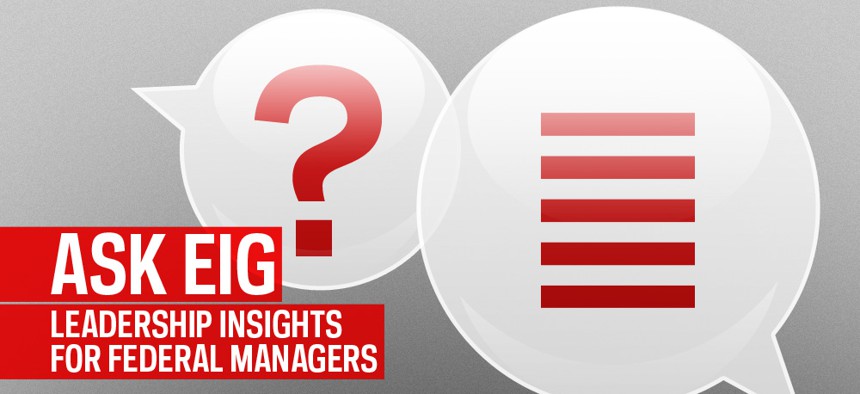If It's So Hard to Fire Feds, Why Are So Many Federal Leaders Risk Averse?
The factors that encourage caution over risk taking.
Ask EIG is your chance to seek answers to public sector management challenges and conundrums. Submit your questions here.
When it’s so hard to fire a federal employee, why are so many federal leaders risk averse? I’ve never seen anybody get canned for making a mistake, yet we all walk on eggshells as if any mistake will mean our heads. Why do you think federal leaders are so unwilling to take chances?
--Anonymous
Several of the recent Ask EIG columns have explored questions about performance measurement and encouraging innovation among workers. This week’s commenter asks a similar question but one that focuses on leaders instead of employees.
A recent report on innovation in the federal work force by the Partnership for Public Service using OPM’s Best Places to Work in the Federal Government survey data, argued that based on the extent to which government agencies are innovative, that on the whole, innovativeness has been slipping in each of the past three years. If being fired is an unlikely and extraordinary act for federal leaders, as the commenter suggests, why might innovativeness be falling? Why are leaders unwilling to take risks, especially when risks in the name of innovation could lead to substantial benefits to agencies and citizens?
(HAVE A QUESTION? Submit your most pressing management questions below or click here)
A first place to look for an explanation is at the benefits versus costs on taking innovation risks. What is the upside if someone takes a risk and it leads to an innovation versus the downside risk of failure? In today’s environment, successful innovation rarely leads to any type of financial reward, especially during the past three years, which may explain why innovativeness generally is in decline. Perhaps a successful innovator receives a reputation boost and receives some acknowledgement, but does success translate into career benefits? With OPM Executive Core Qualifications (ECQs) spanning so many categories (five major ECQs with 28 component competencies) even a successful innovation likely counts for little toward promotion. If too many competencies are measured (in my view, measuring more than a handful dilutes the impact of any one measure) then good performance in one dimension will have little effect on career advancement.
In contrast, what happens if the risk leads to failure? Is the individual congratulated and encouraged to try again because they followed a good process or are they punished, taking a blow to their reputation and subjected to diminished prospects for their advancement? Will such a leader be called in to testify to Congress or receive verbal abuse about wasting taxpayer dollars when the attempt fails? If failure can lead to these bad outcomes then why would anyone ever try to innovate?
Other factors also matter. Substantial, systematic, or radical innovation can require a combination of authorities that reside with different offices and even different agencies. Authorities are difficult, costly, and time-consuming to change and combine in the federal government. In fact, senior leaders may fight to keep their authority to self-justify their position. The reorganization of authorities in the private sector, while also difficult, is much easier that in the federal government. So even if innovation is rewarded in the federal government structure, the inertia of authorities may limit innovation to incremental process improvement and autonomous research projects like those found in agencies like NASA.
Another challenge to innovation is the government policy to measure performance. Such measures and metrics are kind of like the game of baseball but where only runs scored matter. The number of swings and batters battling at plate don’t count. Put differently, in an environment where metrics are about outcomes and not process, what leader is willing to take the risk of missing a performance target or losing any game? The net result is that performance measures undermine risk taking.
Yet, even with all of these pressures lined up against innovation in the government context, innovation can still be found (see for example, Nextgov’s Bold Award nominees). The willingness to engage in innovative efforts naturally depends on the leader’s superordinate and the culture of their agency or unit. Superordinate leaders have the opportunity to insulate their subordinates from the downsides of failed innovation. Based on the Partnership for Public Service’s analysis, it would appear that NASA and the FTC are agencies that on average encourages innovation where other agencies seem to encourage it less so
If you experience a local environment that is not innovative then why not talk about it with your leader? Engage in a conversation about how the leader can change the environment to encourage and protect innovative efforts and risk taking. Help them understand how to increase the upside from taking risks while simultaneously decreasing the downside.
Duce a mente (May you lead by thinking),
Jackson Nickerson








